Theressa and I have been living at the new house she bought since the end of March, so it's about time I gave an update on how things are going here! Theressa bought .2 acres with a small 800-odd square foot shack plus garage/carport/shed. The lot is 50' x 175', with the house set back 80' or so from the street, leaving a 65' long back yard. There's almost no tree cover right now, except for one pine and one cherry in the back yard on the south boundary, a row of black locusts on the east boundary in the back yard, and a cherry and a few more locusts on the east boundary in the front yard. It's nice to have a near blank-slate for designing in full sun.
Soil
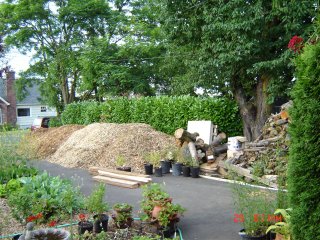 The soil is interesting--incredible drainage, but very little top soil and full of rocks. Apparently this area used to be a river bed. My thought is that there's good nutrients available because of the presence of rocks constantly being weatherized, but that we need heavy additions of organic matter to improve soil structure and hold on to some of the water, and we probably need dynamic accumulator plants to tap into the nutrients that have washed downwards with the rain and bring them back to the surface. So, we've had dozens of loads of wood chips dumped in the driveway and have sheet mulched almost the entire yard to build soil organic matter, add nitrogen via coffee grounds and dumpstered bread (our soil test showed 1 part per million nitrogen, ouch!) and improve soil life (our earthworm population is really really weak). The driveway is currently used to store heaps of wood chips continuing to break down, plus our firewood pile.
The soil is interesting--incredible drainage, but very little top soil and full of rocks. Apparently this area used to be a river bed. My thought is that there's good nutrients available because of the presence of rocks constantly being weatherized, but that we need heavy additions of organic matter to improve soil structure and hold on to some of the water, and we probably need dynamic accumulator plants to tap into the nutrients that have washed downwards with the rain and bring them back to the surface. So, we've had dozens of loads of wood chips dumped in the driveway and have sheet mulched almost the entire yard to build soil organic matter, add nitrogen via coffee grounds and dumpstered bread (our soil test showed 1 part per million nitrogen, ouch!) and improve soil life (our earthworm population is really really weak). The driveway is currently used to store heaps of wood chips continuing to break down, plus our firewood pile.
I tried an experiment a few months after the first layer of sheet mulch. I presprouted three or four jars worth of beans and many more seeds of various Amaranthus sp. (pigweeds) and Chenopodium sp. (lambs quarters and relatives) and sowed them directly into the wood chip sheet mulch. I sowed the beans on top of the wood chips and then covered with about an inch of fresh wood chips. I then sowed the smaller seeds and raked them into the mix. We used the sprinkler for the next few days to keep things moist as the seeds established. I had no idea whether or not it would work, between the hot June sowing, ravaging chickens in the back yard, and general uncertainty of how well the seeds would take to having no actual soil, just wood chips. It turned out fairly well--many bean plants did come up and several developed into very healthy plants (those in the back yard have now been largely devoured by the chickens). The smaller seeds didn't seem to come up at all--I think they should have been sown with the beans and then had the 1" of chips on top of it all. As it was, I think sowing the smaller seeds at the surface and raking them in was inadequate to protect them from drying out in the sun.
Annual beds
 Two or three days after she took possession, we had a load of 6 cubic feet of mixed soil plus 3 cubic feet of potting soil dumped in the double-wide landing-strip driveway (the previous owner had an RV), and within a day or two had four 20' x 4' raised beds laid out and seeds planted. This is our third year of trying to grow annual vegetables, and the first year things have really clicked for us. The beds have kind of petered out now, but for a while we were having large salads every day, and we got lots of beets and carrots and rutabagas from the first round of planting. Very exciting! We've found that the heat of summer on our fully sun-baked garden beds has made it difficult to grow a second round of veggies, especially as we have a lot of projects going on and can't devote all the necessary time to the annuals. Hopefully the fall growing will be a little easier as the heat backs off and rain starts in.
Two or three days after she took possession, we had a load of 6 cubic feet of mixed soil plus 3 cubic feet of potting soil dumped in the double-wide landing-strip driveway (the previous owner had an RV), and within a day or two had four 20' x 4' raised beds laid out and seeds planted. This is our third year of trying to grow annual vegetables, and the first year things have really clicked for us. The beds have kind of petered out now, but for a while we were having large salads every day, and we got lots of beets and carrots and rutabagas from the first round of planting. Very exciting! We've found that the heat of summer on our fully sun-baked garden beds has made it difficult to grow a second round of veggies, especially as we have a lot of projects going on and can't devote all the necessary time to the annuals. Hopefully the fall growing will be a little easier as the heat backs off and rain starts in.
Sharing Garden
Taking a cue from a practice Pam & Joe from the Permaculture Institute had used at their old house, we created a sharing garden right next to the street, with raspberries in a curve enclosing salad plants, strawberries, and four large barrels planted with cherry tomatoes and a nectarine. We encourage passersby to harvest from the area, sharing the wealth and helping people realize where food actually comes from. At first we had a hard time convincing anyone to take any food, but now there seems to be some regular picking of delicacies! Unfortunately, the summer heat has taken its toll on the front area, which is far enough away that it gets even less maintenance including water than do the annual beds next to the house. Permaculture zones in action!
Nursery
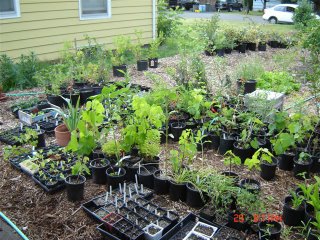 We have a nursery going of plants we bought wholesale last year, plants we've started from seed, and other plants we've accumulated here and there. Although we have planted out lots of annuals already (especially squash and sunflowers) and a few perennials (especially jerusalem artichokes), we're waiting to do any "real", permanent planting until this fall. By then we will hopefully have a fairly good feel for wind and water flow, sun patterns, traffic dynamics, interaction with the house, etc. Probably the planting will be in two stages--one in fall with the plants we already have, and a second in late winter or early spring when new plant orders come in. Meanwhile it's a struggle to keep the nursery watered well with so little shade, but we're doing pretty well! There are a lot of seeds we have which I'd hoped to start this year but didn't get to...hopefully we can organize well enough to do a round of seed starting in the fall for overwintering and germination in the spring.
We have a nursery going of plants we bought wholesale last year, plants we've started from seed, and other plants we've accumulated here and there. Although we have planted out lots of annuals already (especially squash and sunflowers) and a few perennials (especially jerusalem artichokes), we're waiting to do any "real", permanent planting until this fall. By then we will hopefully have a fairly good feel for wind and water flow, sun patterns, traffic dynamics, interaction with the house, etc. Probably the planting will be in two stages--one in fall with the plants we already have, and a second in late winter or early spring when new plant orders come in. Meanwhile it's a struggle to keep the nursery watered well with so little shade, but we're doing pretty well! There are a lot of seeds we have which I'd hoped to start this year but didn't get to...hopefully we can organize well enough to do a round of seed starting in the fall for overwintering and germination in the spring.
The Birds
 We have hens for eggs! We started Helen from a chick last year; she lived at the Permaculture Institute for a few months after we moved out, giving us time to start new chicks and build a hen house. The chickens have the full run of the back yard and are proving to be wonderfully destructive little beasts. It's fun watching them scratch the hell out of plants and wonder exactly what our permanent planting will look like. One of our hens wandered out of the back yard and found a rat trap which gave her a concussion and had us worried about her for several days. :( She seems to be OK now, though after a few name trials we seem to have settled on "Dizzy"--we're guessing she'll never be quite like the rest of the chickens. :/ At this point Helen has been laying regularly and Sexy (our black sexlink) just joined her last week with little teeny tiny cute baby eggs! Here you can see Sexy in action, plundering a sunflower head twice as tall as she! Chickens have wings but can't fly very well, so she's jumping, not flying!
We have hens for eggs! We started Helen from a chick last year; she lived at the Permaculture Institute for a few months after we moved out, giving us time to start new chicks and build a hen house. The chickens have the full run of the back yard and are proving to be wonderfully destructive little beasts. It's fun watching them scratch the hell out of plants and wonder exactly what our permanent planting will look like. One of our hens wandered out of the back yard and found a rat trap which gave her a concussion and had us worried about her for several days. :( She seems to be OK now, though after a few name trials we seem to have settled on "Dizzy"--we're guessing she'll never be quite like the rest of the chickens. :/ At this point Helen has been laying regularly and Sexy (our black sexlink) just joined her last week with little teeny tiny cute baby eggs! Here you can see Sexy in action, plundering a sunflower head twice as tall as she! Chickens have wings but can't fly very well, so she's jumping, not flying!
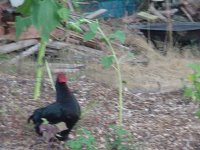 |  |
The Bees
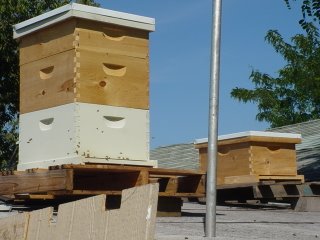 We also have bee hives! We bought two "packages" of bees, which are small cages with a queen and 10,000 worker bees buzzing like crazy. We set one hive up on our roof and the second hive up at Theressa's dad's place, where we've been sheet mulching and planting a food forest since last fall. This past June Theressa caught a swarm of bees from a neighbor's tree way high up, and we set that swarm up on our roof as well. The purchased colonies seem to be doing really well; we've actually added "supers" which are boxes in which bees place their "surplus" honey, the stuff we get to harvest! Normally you don't expect a harvest the first year, so it's exciting to potentially be harvesting already. The swarmed colony, perhaps because it was set up later in the year, seems healthy enough but lacks the honey reserves and full strength of the other two colonies. We might steal some honey from our strong colonies to make sure our swarmed batch can make it through the winter and have a strong start next year.
We also have bee hives! We bought two "packages" of bees, which are small cages with a queen and 10,000 worker bees buzzing like crazy. We set one hive up on our roof and the second hive up at Theressa's dad's place, where we've been sheet mulching and planting a food forest since last fall. This past June Theressa caught a swarm of bees from a neighbor's tree way high up, and we set that swarm up on our roof as well. The purchased colonies seem to be doing really well; we've actually added "supers" which are boxes in which bees place their "surplus" honey, the stuff we get to harvest! Normally you don't expect a harvest the first year, so it's exciting to potentially be harvesting already. The swarmed colony, perhaps because it was set up later in the year, seems healthy enough but lacks the honey reserves and full strength of the other two colonies. We might steal some honey from our strong colonies to make sure our swarmed batch can make it through the winter and have a strong start next year.
It seems that I may be allergic to bees--I had amusingly chipmunk-like swell-up the first time I got stung in the cheek, and a similar reaction the second time I was stung on my foot. Stings since then haven't been nearly a problematic, so I'm not too worried about it, but for now Theressa is the primary beekeeper, with me acting as a cowardly back-seat driver shouting inane instructions and taking pictures from a safe distance.
The Fungi
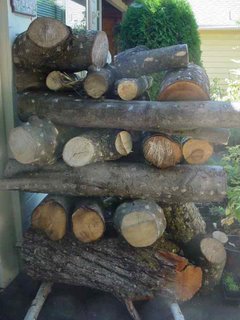 We ordered 2000 plugs inoculated with mushroom spawn--1000 each of Shitake and Oyster mushrooms--and spent a tediously long time drilling holes in big chunks of wood we scavenged here and there, hammering in the plugs, and sealing with beeswax. We have them stacked in a big criss-cross pile on the north side of the house where they can be shaded, and we're keeping them watered. Next year the spawn should have colonized the logs well enough to start producing mushrooms!
We ordered 2000 plugs inoculated with mushroom spawn--1000 each of Shitake and Oyster mushrooms--and spent a tediously long time drilling holes in big chunks of wood we scavenged here and there, hammering in the plugs, and sealing with beeswax. We have them stacked in a big criss-cross pile on the north side of the house where they can be shaded, and we're keeping them watered. Next year the spawn should have colonized the logs well enough to start producing mushrooms!
That about covers the summary of yard projects. We've also been busy canning and preserving gleaned food (blackberries, apples, figs so far), and there's a lot of work to be done on the house itself. I'll write more about house projects later.
No comments:
Post a Comment